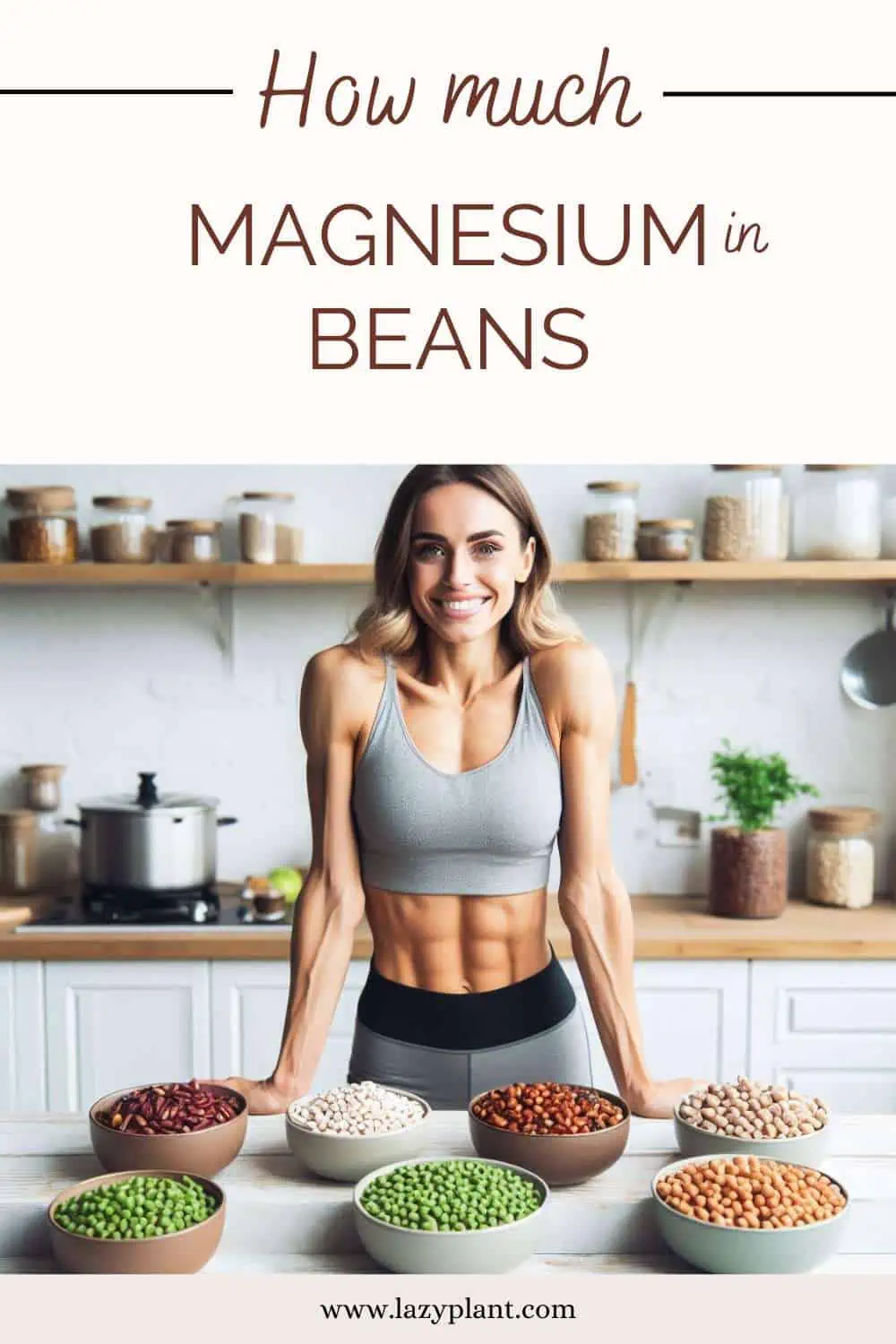Beans are magnesium-rich foods. They can help us meet our daily needs, as they have up to 86 mg of magnesium per 100g, providing 35% of the recommended daily intake per serving!
What’s the magnesium content of beans?
All beans are excellent dietary sources of magnesium. Beans have between 18 and 86 mg of magnesium per 100g. A serving provides up to 150 mg of magnesium. This dose is 35% of the Daily Value (DV).
Soybeans, chickpeas, as well as black, pink, white, navy, and pinto beans provide more magnesium than 20% of the DV per serving!
| magnesium (mg) per 100g | magnesium (mg) per serving | % DV | |
| soybeans | 86 | 148 | 35% |
| black beans | 70 | 120 | 29% |
| pink beans | 65 | 112 | 27% |
| white beans | 63 | 108 | 26% |
| navy beans | 53 | 91 | 22% |
| pinto beans | 50 | 86 | 20% |
| chickpeas | 48 | 83 | 20% |
| red kidney beans | 45 | 77 | 18% |
| lima beans | 43 | 74 | 18% |
| fava beans | 43 | 74 | 18% |
| lentils | 36 | 62 | 15% |
| green beans | 18 | 31 | 7% |
Lima, fava, and red kidney beans have also a high magnesium content, providing 18% of the DV per serving. Lentils have a slightly lower magnesium content.

Only green beans have a low magnesium content, with only 18 mg of magnesium per 100g. Green beans are the beans with the lowest amount of magnesium.
What are the richest beans in magnesium?
Soybeans have the highest magnesium content as compared to other beans. A serving provides 35% of the DV.
Actually, all soy products are high in magnesium. For instance, a serving of tofu or edamame provides 24% DV, whereas a serving of soy milk provides 10% DV!
Soybeans and soy products are particularly rich in many other minerals, such as calcium, potassium, and iron!
Does cooking affect the magnesium content of beans?
Actually, cooking doesn’t affect the magnesium content of beans and other magnesium-rich foods. Magnesium isn’t vulnerable to heat. Neither soaking nor rinsing significantly affects the magnesium content in beans. In fact, the germination process makes beans more digestible.[2]
Keep in mind that certain bean dishes and bad eating habits can make you fat.
What’s the absorption rate of magnesium of beans?
We absorb 30-50% of magnesium of food. The absorption rate mainly depends on the consumed dose. We absorb less magnesium at higher intakes.[3]
Magnesium in beans is highly bioavailable, despite their high oxalate content. Oxalates are compounds that bind to certain minerals, like calcium, inhibiting their absorption. Actually, soaking and rinsing can decrease the total oxalate content of beans.[4]
How to increase the absorption rate of magnesium of beans?
For optimal magnesium absorption, we have to get adequate amounts of:
- vitamin D, as it stimulates intestinal magnesium absorption.[5]
- calcium. Actually, too little or too much calcium may negatively affect the absorption rate of magnesium. The calcium/magnesium ratio should be between 1.70 and 2.60.[6]
- protein and fructose. Eat beans with whole-grain bread, rice, quinoa, or chia seeds in order to consume a complete plant-based protein. Fruits are the healthiest dietary sources of fructose.[7]

What inhibits the absorption of magnesium of beans?
The absorption rate of magnesium of beans depends on many factors. For instance, extremely high doses of zinc or vitamin D, smoking, alcohol abuse, or taking certain drugs may interfere with the absorption of magnesium.
What’s the recommended daily intake?
The recommended daily intake of magnesium is 400-420 mg for adult men and 310-320 mg for adult women. Teenagers and pregnant women also require high doses (360-410 mg).[8]
Can we depend on beans to meet our daily needs?
Certainly, beans are excellent dietary sources of magnesium. They can help us meet our daily needs. But, we have to consume a wide variety of magnesium-rich foods to get the recommended daily intake.
Can we get too much magnesium from beans?
Healthy people can’t get too much magnesium from beans or other magnesium-rich foods. The kidneys eliminate excess amounts in the urine. However, patients with impaired renal function or kidney failure can get too much magnesium from diet. In certain diseases, the kidneys can’t remove excess magnesium.
Always consult your physician before changing your diet or taking dietary supplements.
Common foods high in magnesium
Magnesium is naturally found in both animal (e.g. milk, dairy, fish, eggs, meat) and plant-based foods, as well as certain beverages. Green leafy vegetables, legumes, nuts, seeds, whole grains, and certain fruits are good sources of magnesium. In general, foods high in fiber are also high in magnesium.
Consuming a serving of pumpkin seeds, chia seeds, almonds, or spinach is the easiest way to boost your daily intake of magnesium. These are the richest foods in magnesium. They provide 19-37% DV per serving!
Banana and avocado are the richest fruits in magnesium.
Water can be a good source of magnesium as well. Water can provide 6-31% of the required daily intake of magnesium a day.
Unfortunately, dietary surveys in the United States consistently show that many people consume less than the recommended daily intake of magnesium. But, following a well-balanced, plant-based diet can provide more than enough magnesium for healthy people.
You can boost your daily magnesium intake with dietary supplements. You can find a wide variety of magnesium supplements on iHerb.